Window-Based Energy Selecting X-ray Imaging and Charge Sharing in Cadmium Zinc Telluride Linear Array Detectors for Contaminant Detection
Abstract
:1. Introduction
2. The CZT-Based ERPC Prototype
2.1. The CZT Linear Array Detector
2.2. The Readout Electronics
3. The Spectroscopic Response of the CZT-Based ERPC Prototype
4. Charge Sharing and Incomplete Charge Collection Effects
4.1. Charge Sharing Measurements
4.2. Incomplete Charge Collection in Single Events
4.3. Incomplete Charge Collection in Charge Sharing Events
5. Energy-Resolved Images and Contrast Enhancements in a Food Sample
5.1. Experimental Set-Up and Data Acquisition
- images with the presence of charge sharing in each pixel (Raw images);
- images including only the charge sharing between adjacent pixels and rejecting the charge sharing with the internal guard-ring (G-CSD images);
- images after full charge sharing discrimination (CSD), i.e., after rejecting all charge sharing events in each pixel (CSD images).
5.2. Image Processing and Figure of Merit for Image Quality
5.3. Energy-Resolved Imaging and Contrast Enhancements
- -
- first, we fixed the same width w of the energy windows for both contaminant and background; in our case we were able to select 40 different energy-window widths, with a step of 1 keV, within the energy range R of 45 keV (5–50 keV); the minimum w was fixed to 5 keV, taking into account the energy resolution of the system (w ≥ 2·FWHM~5 keV within the 50–5 keV energy range); we stress that the use of a w of 45 keV, for both contaminant and background, was equivalent to the application of the photon counting (PC) mode;
- -
- second, for each fixed w value, we selected the optimal position of the windows in the energy range, taking into account the highest CNR value among the values obtained from all possible positions (step of 1 keV); for example, by using two window widths ws of 44 keV, the number of possible position values was 4 (two different positions for the contaminant and two for the background), by using two ws of 43 keV, 9 positions and by using two generic ws, we could analyze (R-w + 1)2 different positions.
6. Discussion and Conclusions
- the realization of inter-pixel gap of 25 µm on pixel pitches of 250 µm allowed the reduction in charge sharing percentages (50% at 60 keV in our case; >70% at 60 keV with wider inter-pixel gaps) [23,30]; moreover, this also produced a reduction of the charge losses after CSA (2 keV at 60 keV in our case; >5 keV at 60 keV with wider inter-pixel gaps);
- the coincidence measurements of the shared events after CSA with the cathode events clearly highlighted that the charge losses after CSA are not related to the hole trapping, but they are due to distortions of the electric field lines near the inter-pixel gap;
- the good energy resolution (<3 keV) of the ERPC prototype allowed interesting image quality improvements after the application of energy-resolved techniques;
- a new energy-resolved approach, termed window-based energy selecting, was developed and excellent CNR enhancements in X-ray images were obtained, if compared with other energy-resolved techniques;
- the presence of charge sharing between adjacent pixels (G-CSD images) produced low distortions in CNR; CNRsteel deteriorated of 4% and CNRplastics of 30% from images with no charge sharing (CSD images).
Author Contributions
Funding
Data Availability Statement
Conflicts of Interest
References
- Barber, W.C.; Wessel, J.C.; Nygard, E.; Iwanczyk, J.S. Energy dispersive CdTe and CdZnTe detectors for spectral clinical CT and NDT applications. Nucl. Instr. Meth. A 2015, 784, 531–537. [Google Scholar] [CrossRef] [PubMed] [Green Version]
- Iwanczyk, J.; Nygard, E.; Meirav, O.; Arenson, J.; Barber, W.C.; Hartsough, N.E.; Malakhov, N.; Wessel, J.C. Photon Counting Energy Dispersive Detector Arrays for X-ray Imaging. IEEE Trans. Nucl. Sci. 2009, 56, 535–542. [Google Scholar] [CrossRef] [Green Version]
- Szeles, C.; Soldner, S.A.; Vydrin, S.; Graves, J.; Bale, D.S. CdZnTe Semiconductor Detectors for Spectroscopic X-ray Imaging. IEEE Trans. Nucl. Sci. 2008, 55, 572–582. [Google Scholar] [CrossRef]
- Iniewski, K. CZT detector technology for medical imaging. J. Instrum. 2014, 9, C11001. [Google Scholar] [CrossRef]
- Taguchi, K.; Iwanczyk, J.S. Vision 20/20: Single photon counting X-ray detectors in medical imaging. Med. Phys. 2013, 40, 100901. [Google Scholar] [CrossRef] [PubMed] [Green Version]
- Nguyen, J.; Rodesch, P.A.; Richtsmeier, D.; Iniewski, K.; Bazalova-Carter, M. Optimization of a CZT photon counting detector for contaminant detection. J. Instrum. 2021, 16, P11015. [Google Scholar] [CrossRef]
- Richtsmeier, D.; Guliyev, E.; Iniewski, K.; Bazalova-Carter, M. Contaminant detection in non-destructive testing using a CZT photon-counting detector. J. Instrum. 2021, 16, P01011. [Google Scholar] [CrossRef]
- Roque, G.; Schütz, M.K.; Fey, J.; Useche, J.S.; Fiederle, M.; Procz, S. Sub-pixel energy-weighting techniques for metallic contaminant highlighting in a pharmaceutical hard capsule using a Timepix3 CdZnTe hybrid pixel detector. J. Instrum. 2022, 17, P10030. [Google Scholar] [CrossRef]
- Shikhaliev, P.M. Beam hardening artefacts in computed tomography with photon counting, charge integrating and energy weighting detectors: A simulation study. Phys. Med. Biol. 2005, 50, 5813–5827. [Google Scholar] [CrossRef]
- Wang, X.; Meier, D.; Taguchi, K.; Wagenaar, D.J.; Patt, B.E.; Frey, E.C. Material separation in X-ray CT with energy resolved photon-counting detectors. Med. Phys. 2011, 38, 1534–1546. [Google Scholar] [CrossRef] [Green Version]
- Giersch, J.; Niederlöhner, D.; Anton, G. The influence of energy weighting on X-ray imaging quality. Nucl. Instrum. Methods Phys. Res. Sect. A Accel. Spectrometers Detect. Assoc. Equip. 2004, 531, 68–74. [Google Scholar] [CrossRef]
- Kimoto, N.; Hayashi, H.; Asakawa, T.; Lee, C.; Asahara, T.; Maeda, T.; Goto, S.; Kanazawa, Y.; Katsumata, A.; Yamamoto, S.; et al. Effective atomic number image determination with an energy-resolving photon-counting detector using polychromatic X-ray attenuation by correcting for the beam hardening effect and detector response. Appl. Radiat. Isot. 2021, 170, 109617. [Google Scholar] [CrossRef] [PubMed]
- Zappettini, A.; Marchini, L.; Zha, M.; Benassi, G.; Zambelli, N.; Calestani, D.; Zanotti, L.; Gombia, E.; Mosca, R.; Zanichelli, M.; et al. Growth and Characterization of CZT Crystals by the Vertical Bridgman Method for X-ray Detector Applications. IEEE Trans. Nucl. Sci. 2011, 58, 2352–2356. [Google Scholar] [CrossRef] [Green Version]
- Auricchio, N.; Marchini, L.; Caroli, E.; Zappettini, A.; Abbene, L.; Honkimaki, V. Charge transport properties in CdZnTe detectors grown by the vertical Bridgman technique. J. Appl. Phys. 2011, 110, 124502. [Google Scholar] [CrossRef]
- Abbene, L.; Gerardi, G.; Turturici, A.; Raso, G.; Benassi, G.; Bettelli, M.; Zambelli, N.; Zappettini, A.; Principato, F. X-ray response of CdZnTe detectors grown by the vertical Bridgman technique: Energy, temperature and high flux effects. Nucl. Instrum. Methods Phys. Res. Sect. A Accel. Spectrometers Detect. Assoc. Equip. 2016, 835, 1–12. [Google Scholar] [CrossRef]
- Turturici, A.; Abbene, L.; Gerardi, G.; Benassi, G.; Bettelli, M.; Calestani, D.; Zambelli, N.; Raso, G.; Zappettini, A.; Principato, F. Electrical properties of Au/CdZnTe/Au detectors grown by the boron oxide encapsulated Vertical Bridgman technique. Nucl. Instrum. Methods Phys. Res. Sect. A Accel. Spectrometers Detect. Assoc. Equip. 2016, 830, 243–250. [Google Scholar] [CrossRef]
- Abbene, L.; Principato, F.; Gerardi, G.; Buttacavoli, A.; Cascio, D.; Bettelli, M.; Amadè, N.S.; Seller, P.; Veale, M.C.; Fox, O.; et al. Room-Temperature X-ray response of cadmium-zinc-Telluride pixel detectors grown by the vertical Bridgman technique. J. Synchrotron Radiat. 2020, 27, 319–328. [Google Scholar] [CrossRef] [Green Version]
- Mele, F.; Quercia, J.; Abbene, L.; Benassi, G.; Bettelli, M.; Buttacavoli, A.; Principato, F.; Zappettini, A.; Bertuccio, G. Advances in High Energy Resolution CdZnTe Linear Array Pixel Detectors with Fast and Low Noise Readout Electronics. Sensors 2023, 23, 2167. [Google Scholar] [CrossRef] [PubMed]
- Abbene, L.; Gerardi, G.; Turturici, A.A.; Del Sordo, S.; Principato, F. Experimental results from Al/p-CdTe/Pt X-ray detectors. Nucl. Instr. Meth. A 2013, 730, 135–140. [Google Scholar] [CrossRef]
- Principato, F.; Turturici, A.A.; Gallo, M.; Abbene, L. Polarization phenomena in Al/p-CdTe/Pt X-ray detectors. Nucl. Instrum. Methods Phys. Res. Sect. A Accel. Spectrometers Detect. Assoc. Equip. 2013, 730, 141–145. [Google Scholar] [CrossRef]
- Principato, F.; Gerardi, G.; Abbene, L. Time-dependent current-voltage characteristics of Al/p-CdTe/Pt X-ray detectors. J. Appl. Phys. 2012, 112, 094506. [Google Scholar] [CrossRef]
- Farella, I.; Montagna, G.; Mancini, A.M.; Cola, A. Study on Instability Phenomena in CdTe Diode-Like Detectors. IEEE Trans. Nucl. Sci. 2009, 56, 1736–1742. [Google Scholar] [CrossRef]
- Abbene, L.; Principato, F.; Gerardi, G.; Bettelli, M.; Seller, P.; Veale, M.C.; Zappettini, A. Digital fast pulse shape and height analysis on cadmium–zinc–telluride arrays for high-flux energy-resolved X-ray imaging. J. Synchrotron Radiat. 2018, 25, 257–271. [Google Scholar] [CrossRef]
- Abbene, L.; Gerardi, G.; Raso, G.; Basile, S.; Brai, M.; Principato, F. Energy resolution and throughput of a new real time digital pulse processing system for X-ray and gamma ray semiconductor detectors. J. Instrum. 2013, 8, P07019. [Google Scholar] [CrossRef]
- Gerardi, G.; Abbene, L. A digital approach for real time high-rate high-resolution radiation measurements. Nucl. Instrum. Methods Phys. Res. Sect. A Accel. Spectrometers Detect. Assoc. Equip. 2014, 768, 46–54. [Google Scholar] [CrossRef] [Green Version]
- Abbene, L.; Gerardi, G.; Principato, F.; Buttacavoli, A.; Altieri, S.; Protti, N.; Tomarchio, E.; Del Sordo, S.; Auricchio, N.; Bettelli, M.; et al. Recent advances in the development of high-resolution 3D cadmium–zinc–telluride drift strip detectors. J. Synchrotron Radiat. 2020, 27, 1564–1576. [Google Scholar] [CrossRef]
- Abbene, L.; Principato, F.; Buttacavoli, A.; Gerardi, G.; Bettelli, M.; Zappettini, A.; Altieri, S.; Auricchio, N.; Caroli, E.; Zanettini, S.; et al. Potentialities of high-resolution 3-D CZT drift strip detectors for prompt gamma-ray measurements in BNCT. Sensors 2022, 22, 1502. [Google Scholar] [CrossRef]
- Shor, A.; Eisen, Y.; Mardor, I. Optimum spectroscopic performance from CZT γ- and X-ray detectors with pad and strip segmentation. Nucl. Instrum. Methods Phys. Res. Sect. A Accel. Spectrometers Detect. Assoc. Equip. 1999, 428, 182–192. [Google Scholar] [CrossRef]
- Van Pamelen, M.A.J.; Budtz-Jorgensen, C. CdZnTe drift detector with correction for hole trapping. Nucl. Instrum. Methods Phys. Res. Sect. A Accel. Spectrometers Detect. Assoc. Equip. 1998, 411, 197–200. [Google Scholar] [CrossRef]
- Abbene, L.; Gerardi, G.; Principato, F.; Bettelli, M.; Seller, P.; Veale, M.C.; Fox, O.; Sawhney, K.; Zambelli, N.; Benassi, G.; et al. Dual-polarity pulse processing and analysis for charge-loss correction in cadmium–zinc–telluride pixel detectors. J. Synchrotron Radiat. 2018, 25, 1078–1092. [Google Scholar] [CrossRef]
- Buttacavoli, A.; Gerardi, G.; Principato, F.; Mirabello, M.; Cascio, D.; Raso, G.; Bettelli, M.; Zappettini, A.; Seller, P.; Veale, M.; et al. Energy Recovery of Multiple Charge Sharing Events in Room Temperature Semiconductor Pixel Detectors. Sensors 2021, 21, 3669. [Google Scholar] [CrossRef] [PubMed]
- Buttacavoli, A.; Principato, F.; Gerardi, G.; Bettelli, M.; Amadè, N.S.; Zappettini, A.; Seller, P.; Veale, M.C.; Fox, O.; Sawhney, K.; et al. Room-temperature performance of 3 mm-thick cadmium zinc telluride pixel detectors with sub-millimetre pixelization. J. Synchrotron Radiat. 2020, 27, 1180–1189. [Google Scholar] [CrossRef] [PubMed]
- Koch-Mehrin, K.A.; Bugby, S.L.; Lees, J.E.; Veale, M.C.; Wilson, M.D. Charge Sharing and Charge Loss in High-Flux Capable Pixelated CdZnTe Detectors. Sensors 2021, 21, 3260. [Google Scholar] [CrossRef] [PubMed]
- Buttacavoli, A.; Principato, F.; Gerardi, G.; Cascio, D.; Raso, G.; Bettelli, M.; Zappettini, A.; Seller, P.; Veale, M.C.; Abbene, L. Incomplete Charge Collection at Inter-Pixel Gap in Low-and High-Flux Cadmium Zinc Telluride Pixel Detectors. Sensors 2022, 22, 1441. [Google Scholar] [CrossRef] [PubMed]
- Lloyd, S.P. Least Squares Quantization in PCM. IEEE Trans. Inf. Theory 2022, 28, 129–137. [Google Scholar] [CrossRef] [Green Version]
- O’Connell, J.; Murphy, K.; Robinson, S.; Iniewski, K.; Bazalova-Carter, M. Unsupervised Learning Methods in X-ray Spectral Imaging Material Segmentation. J. Instrum. 2019, 14, P06022. [Google Scholar] [CrossRef] [Green Version]
- Taormina, V.; Cascio, D.; Abbene, L.; Raso, G. Performance of Fine-Tuning Convolutional Neural Networks for HEp-2 Image Classification. Appl. Sci. 2020, 10, 6940. [Google Scholar] [CrossRef]
- Arthur, D.; Vassilvitskii, S. k-means++: The advantages of careful seeding. In Proceedings of the Eighteenth Annual ACM-SIAM Symposium on Discrete Algorithms, New Orleans, LA, USA, 7–9 January 2007; pp. 1027–1035. [Google Scholar]
- Schmidt, T.G. Optimal “image-based” weighting for energy-resolved CT. Med. Phys. 2009, 36, 3018–3027. [Google Scholar] [CrossRef]
- Cahn, R.N.; Cederström, B.; Danielsson, M.; Hall, A.; Lundqvist, M.; Nygren, D. Detective quantum efficiency dependence on X-ray energy weighting in mammography. Med. Phys. 1999, 26, 2680–2683. [Google Scholar] [CrossRef]
- Meng, B.; Cong, W.; Xi, Y.; De Man, B.; Wang, G. Energy Window Optimization for X-ray K-edge Tomographic Imaging. IEEE Trans. Biomed. Eng. 2016, 63, 1623–1630. [Google Scholar] [CrossRef] [Green Version]
- Buttacavoli, A.; Principato, F.; Gerardi, G.; Bettelli, M.; Zappettini, A.; Seller, P.; Veale, M.C.; Zanettini, S.; Abbene, L. Ballistic Deficit Pulse Processing in Cadmium–Zinc–Telluride Pixel Detectors for High-Flux X-ray Measurements. Sensors 2022, 22, 3409. [Google Scholar] [CrossRef] [PubMed]
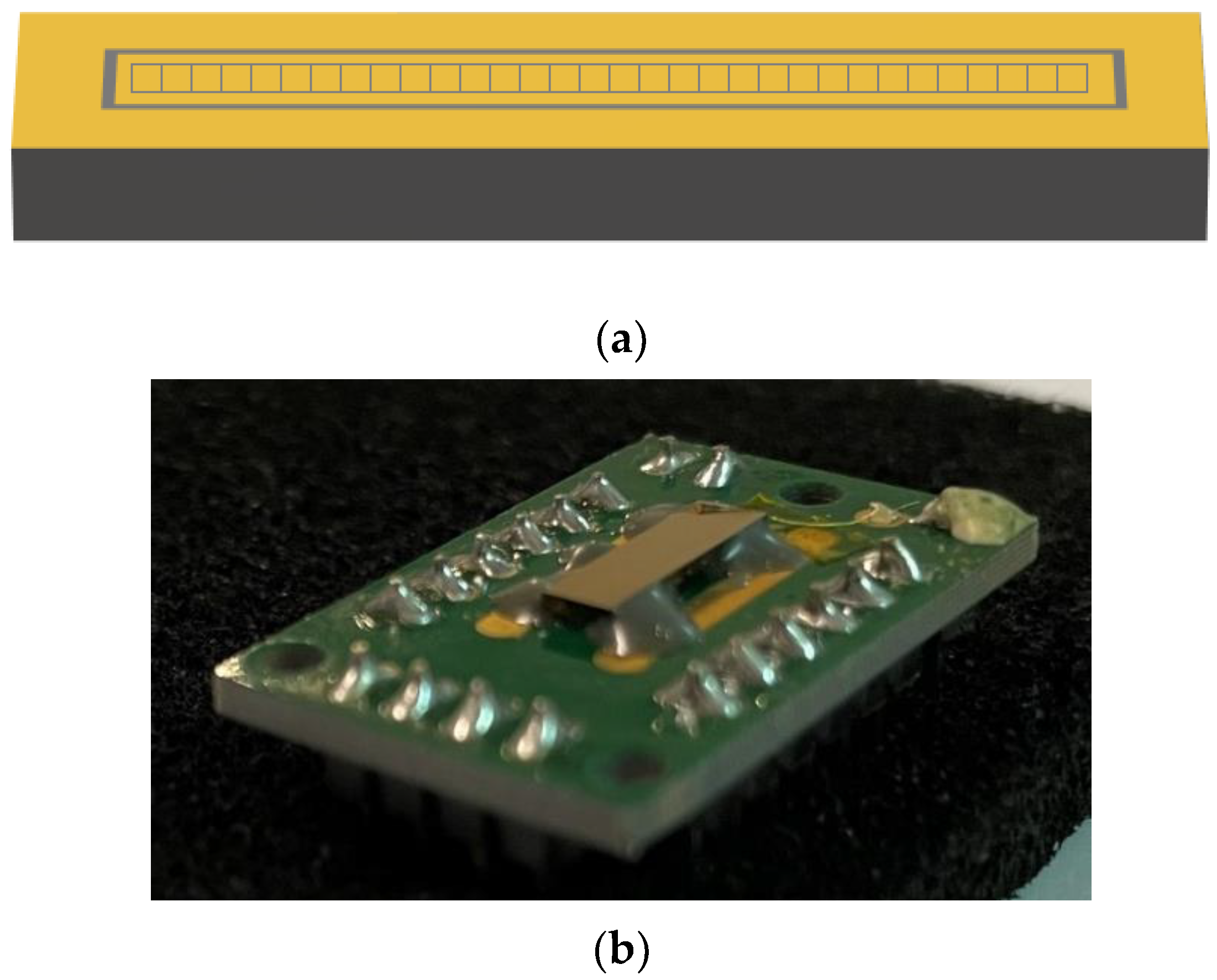
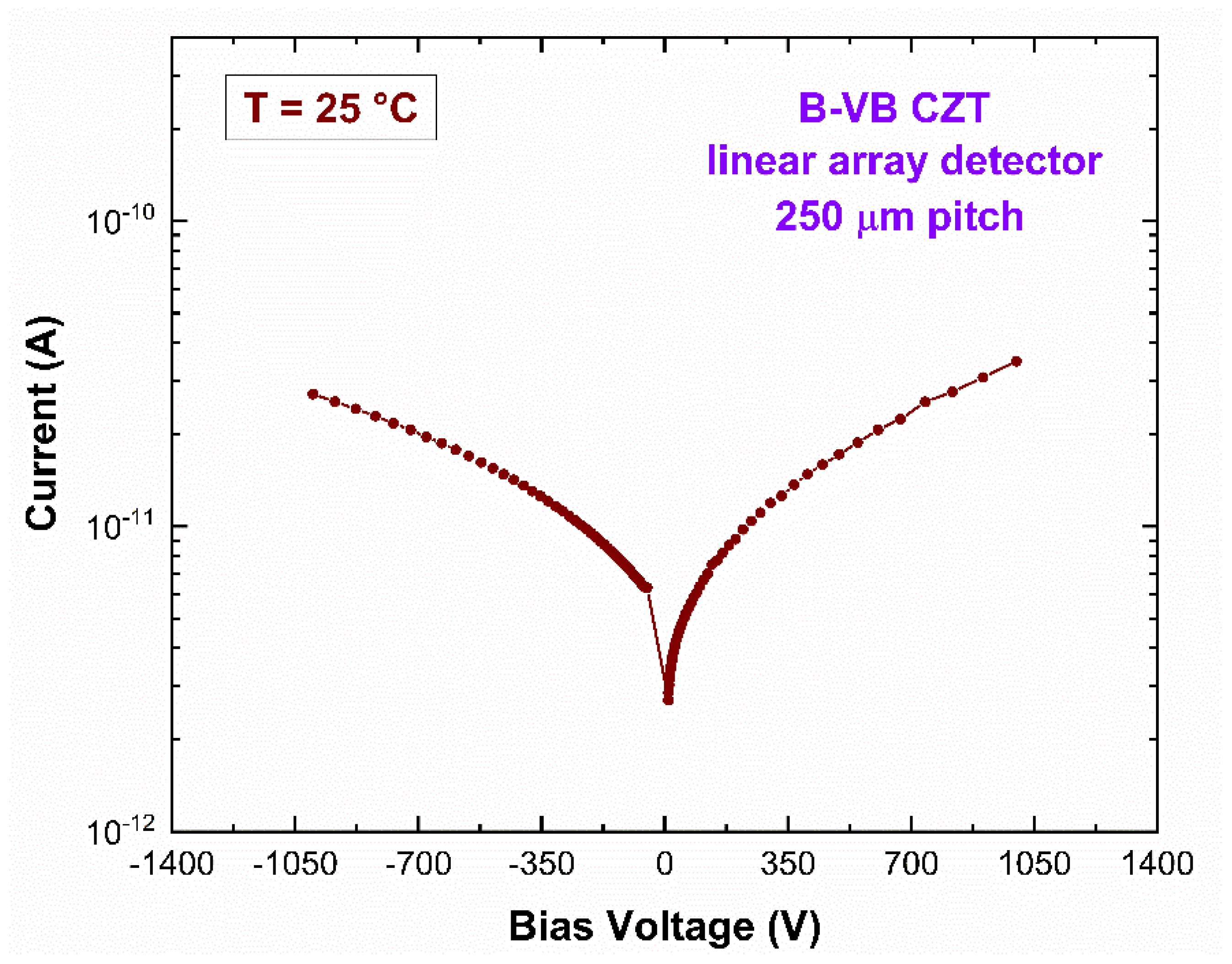
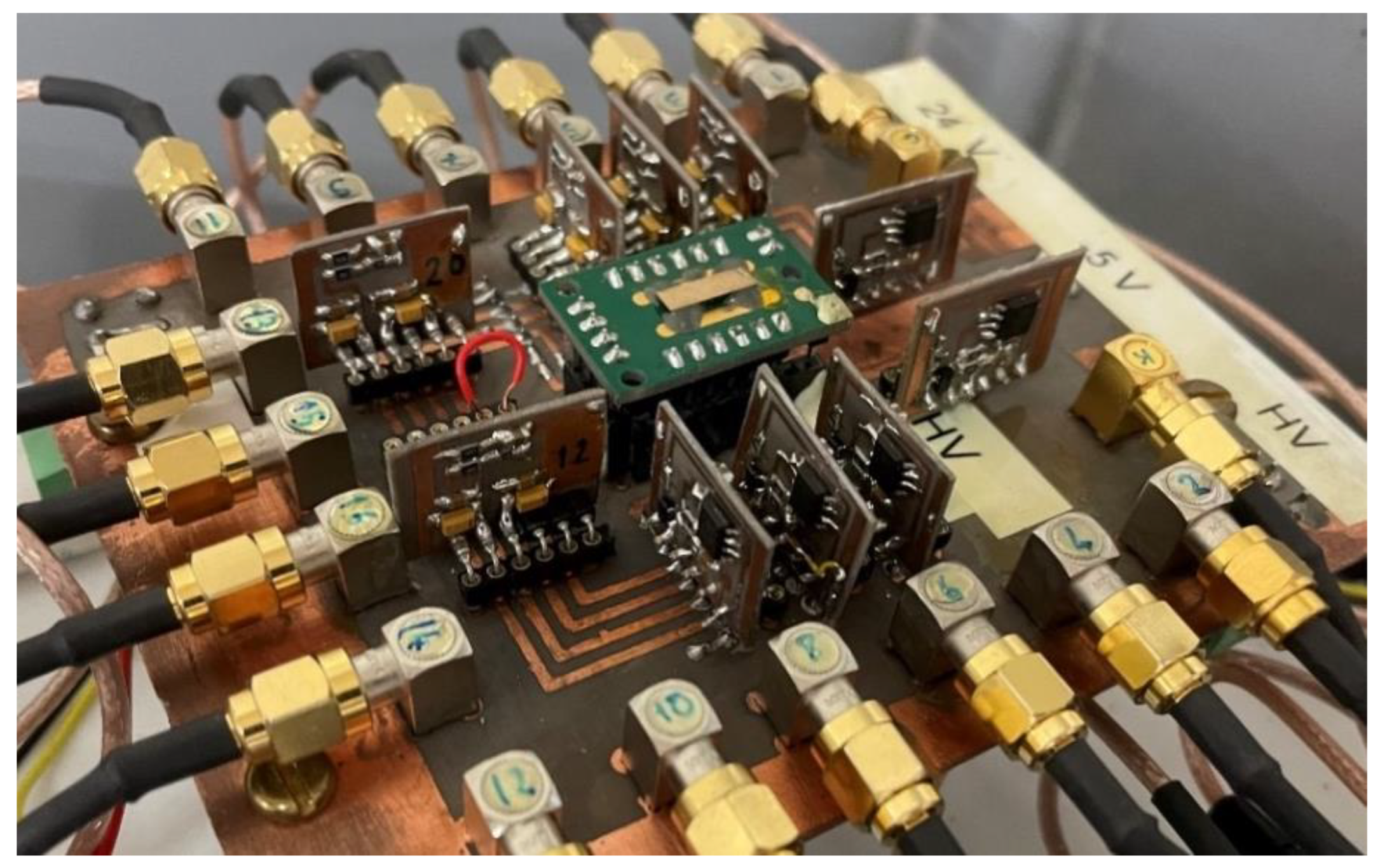
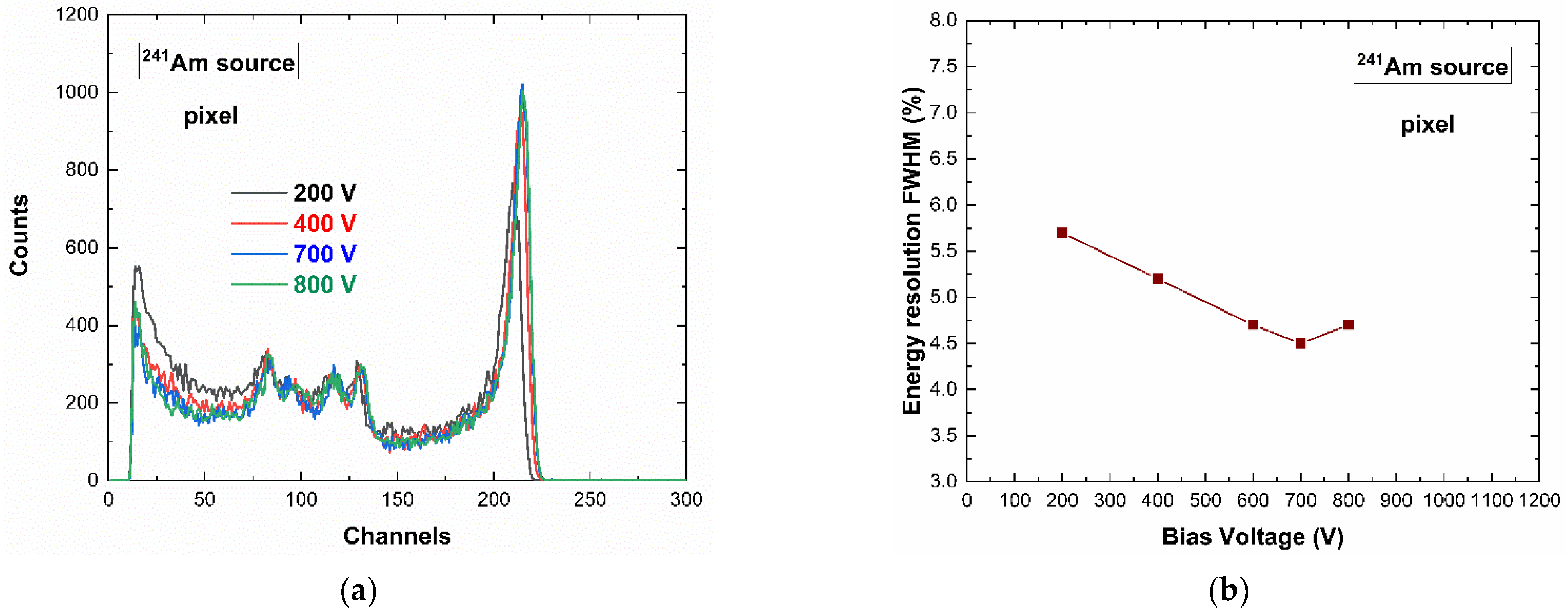
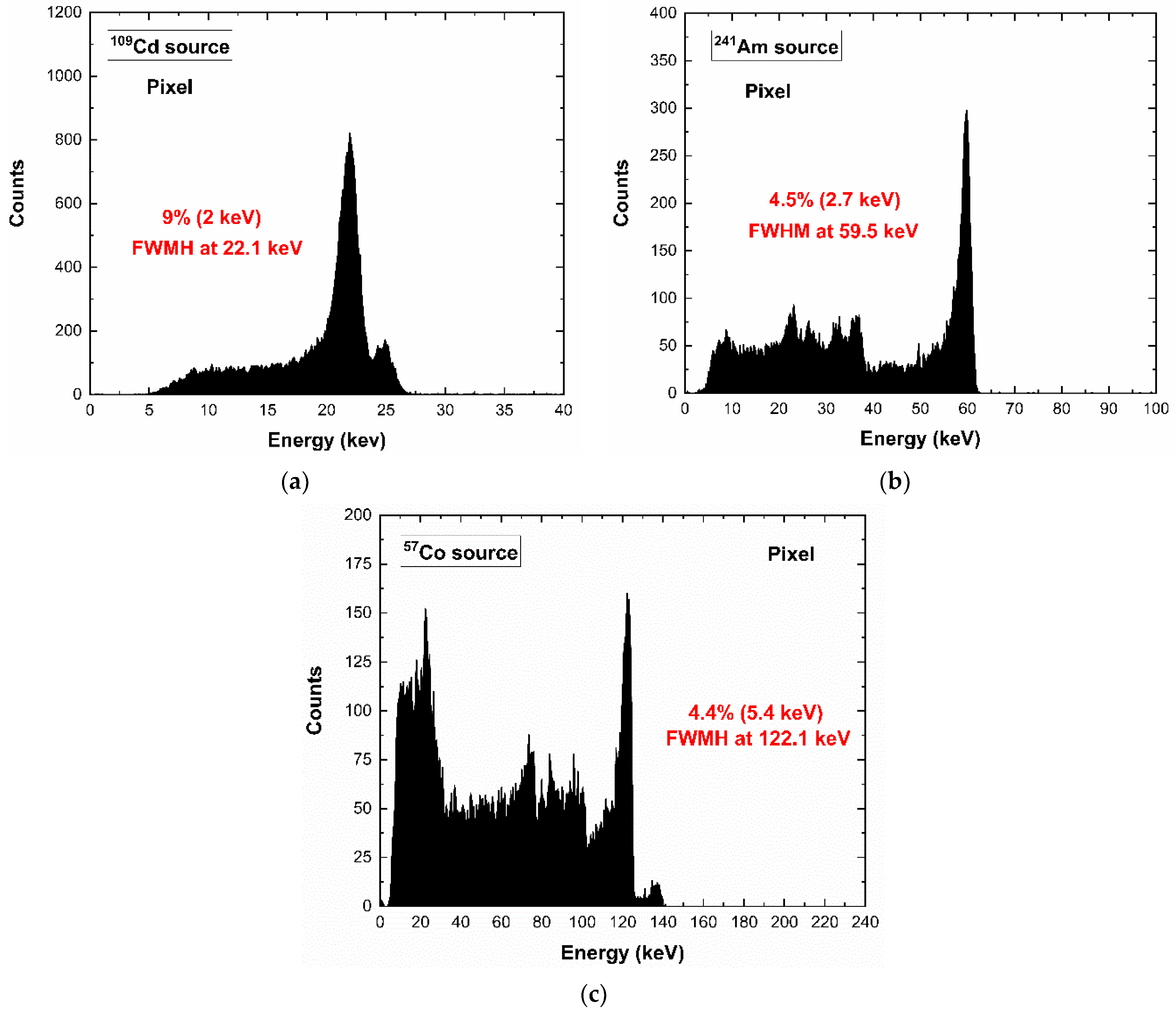
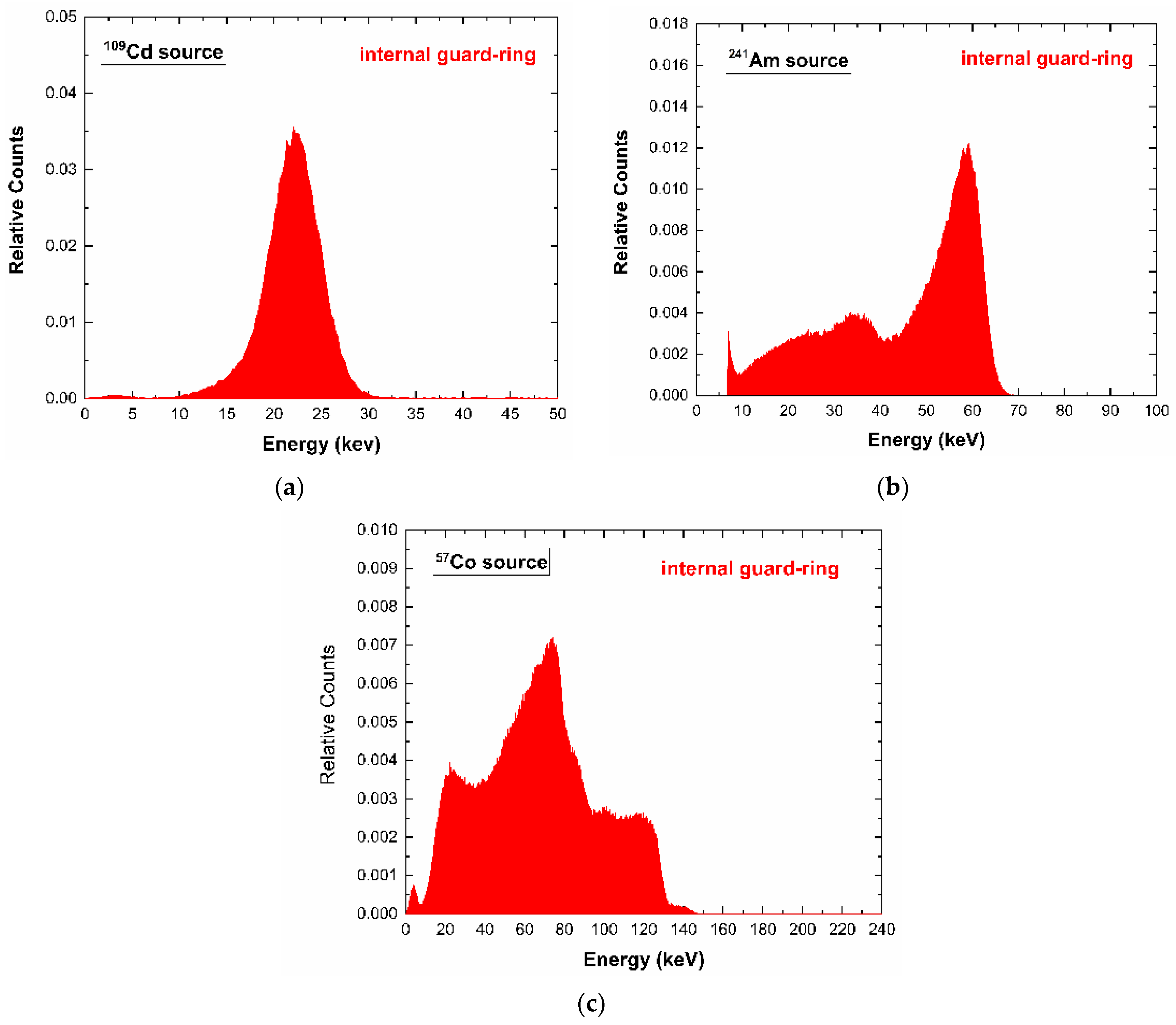

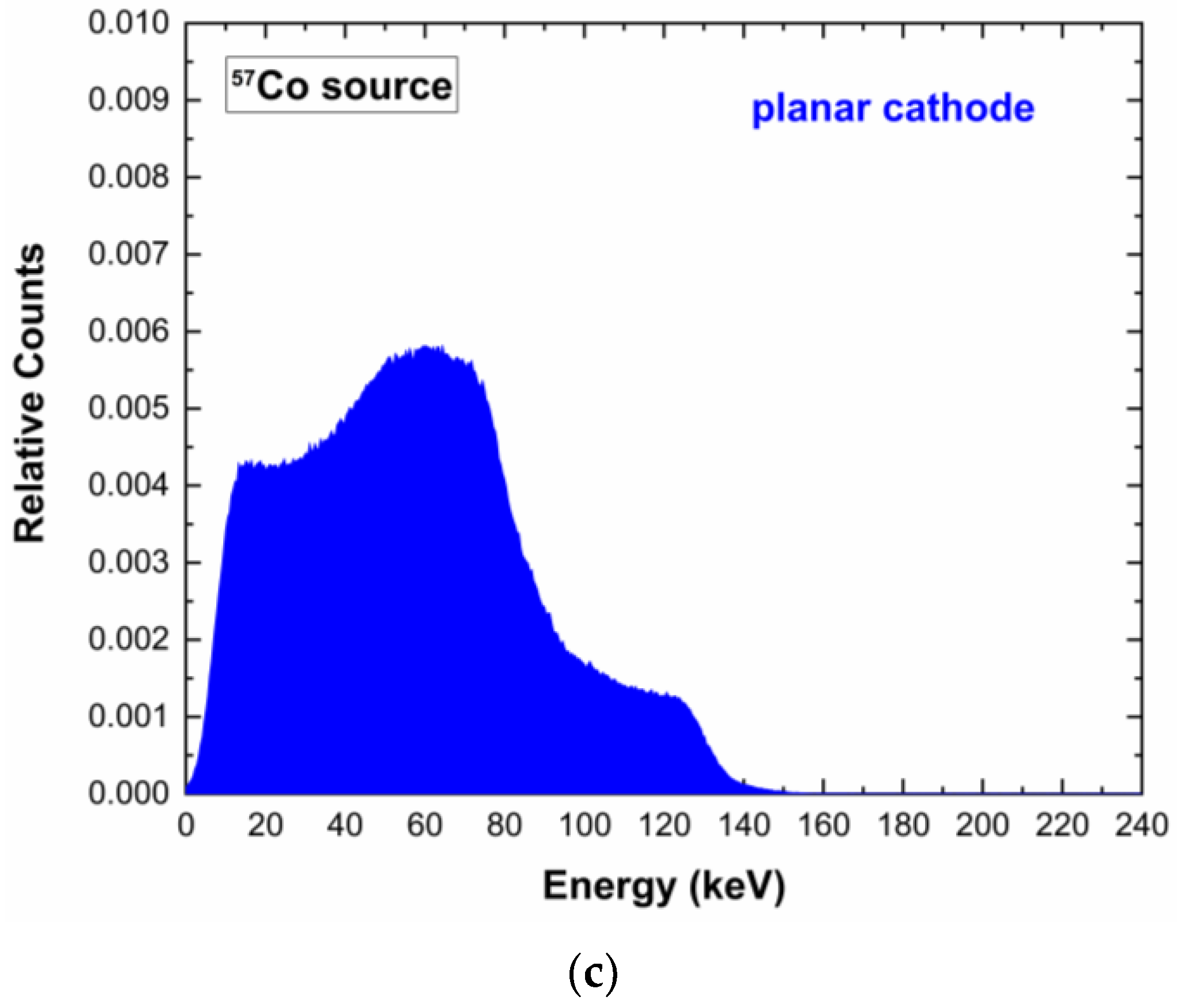

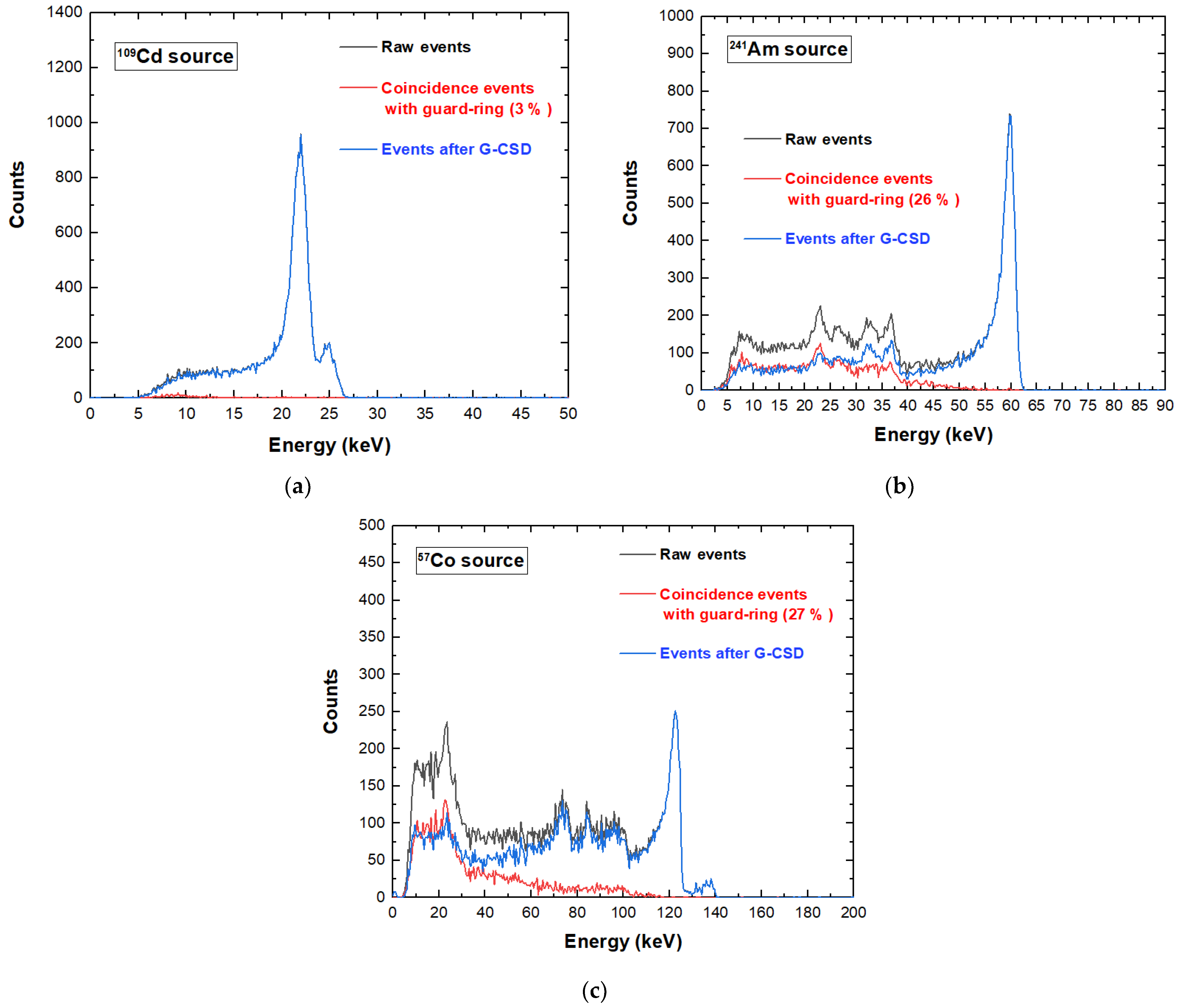
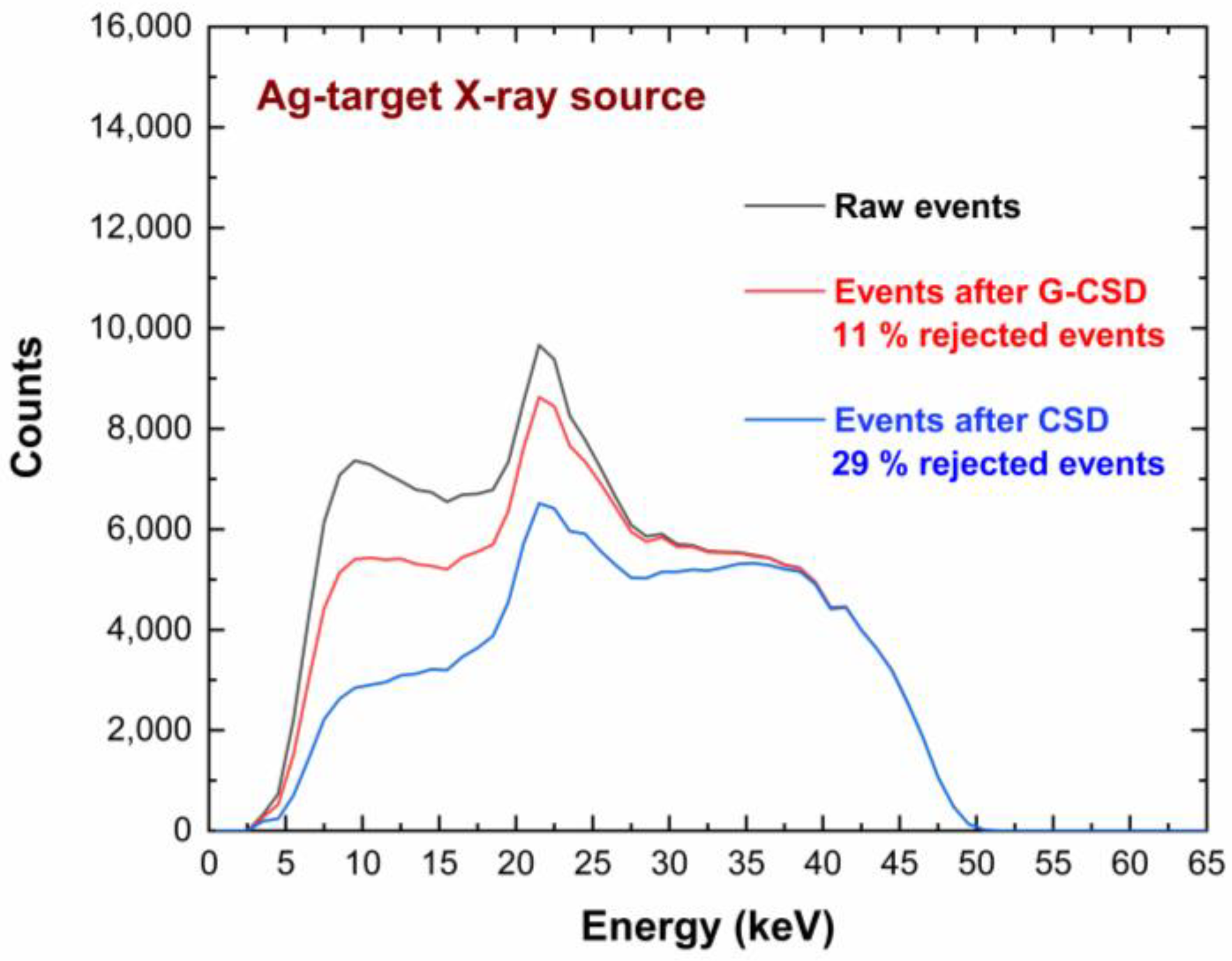

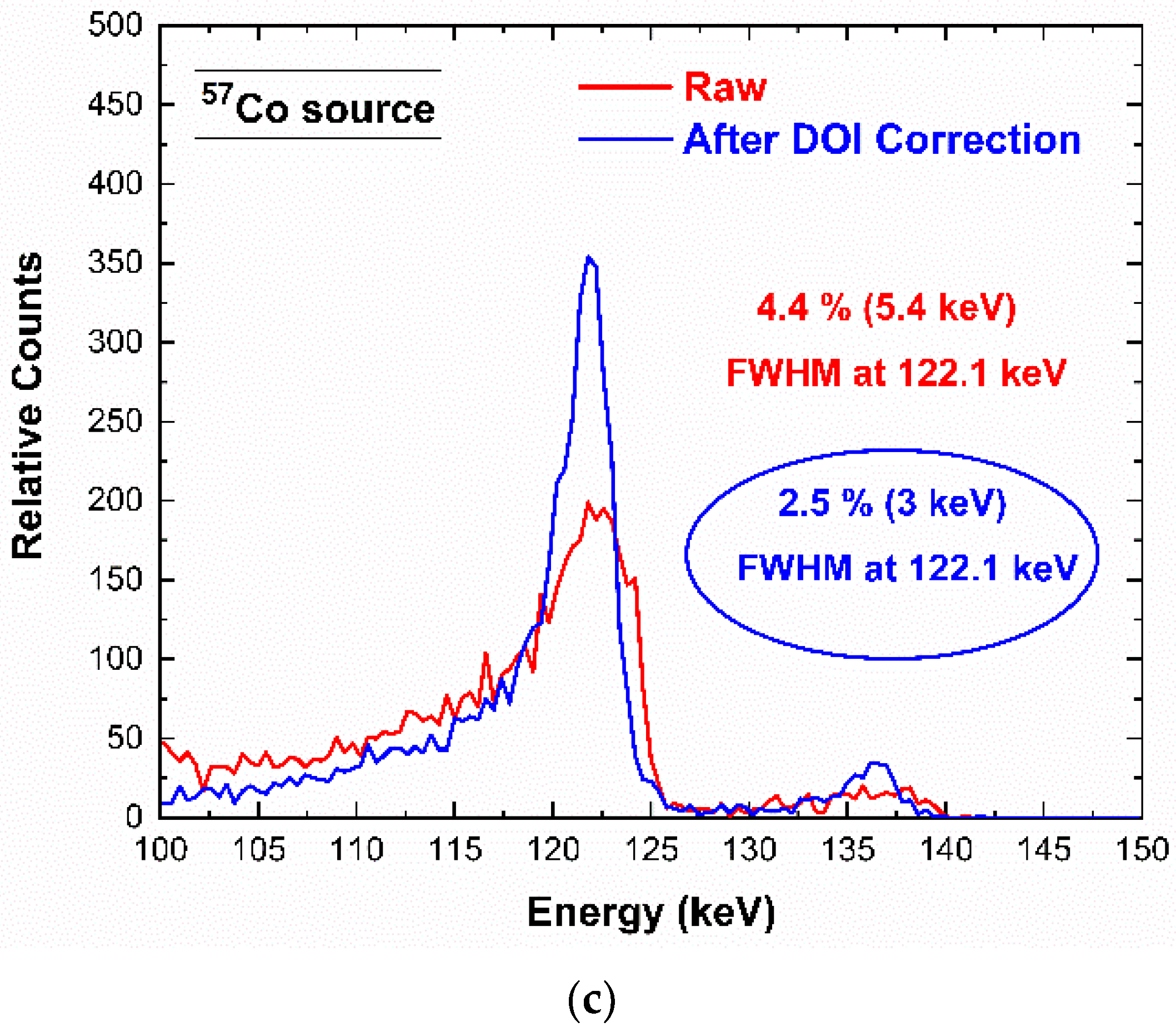
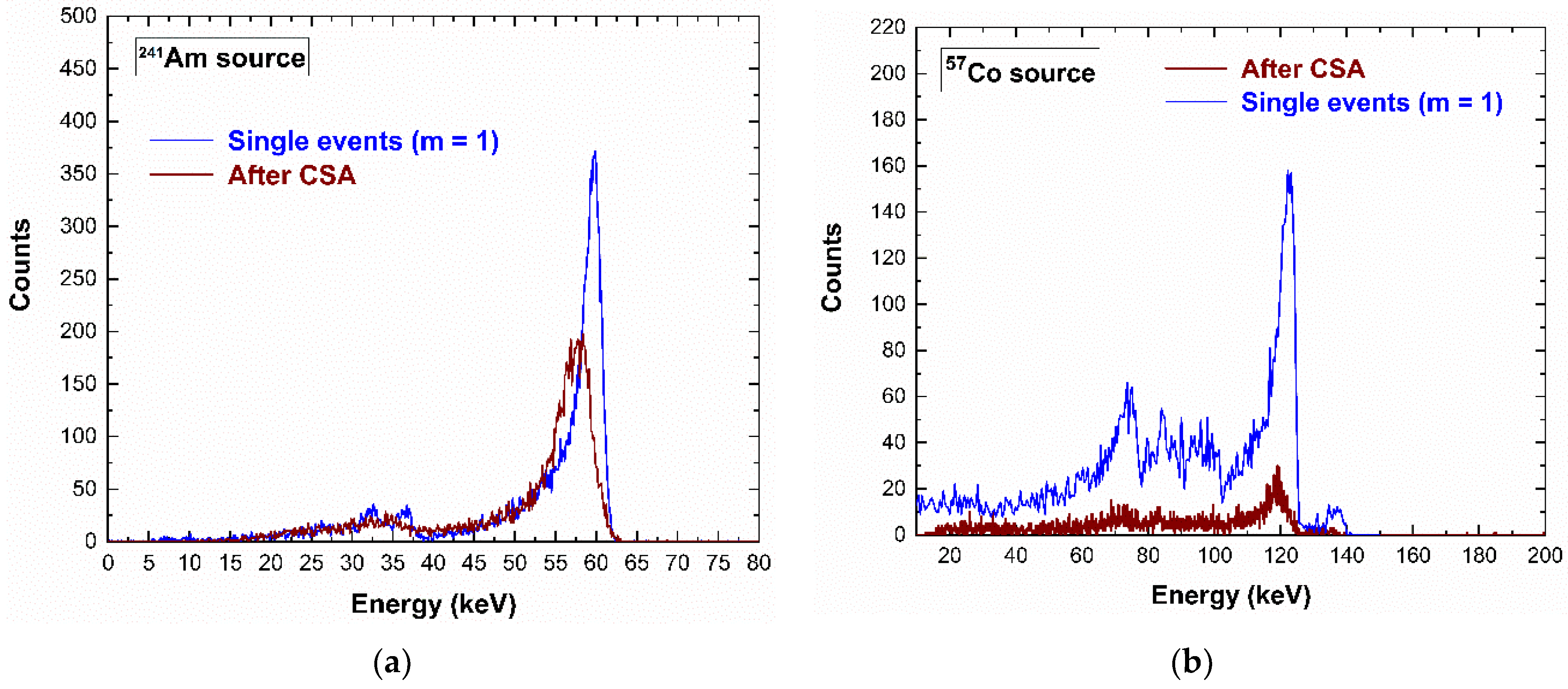
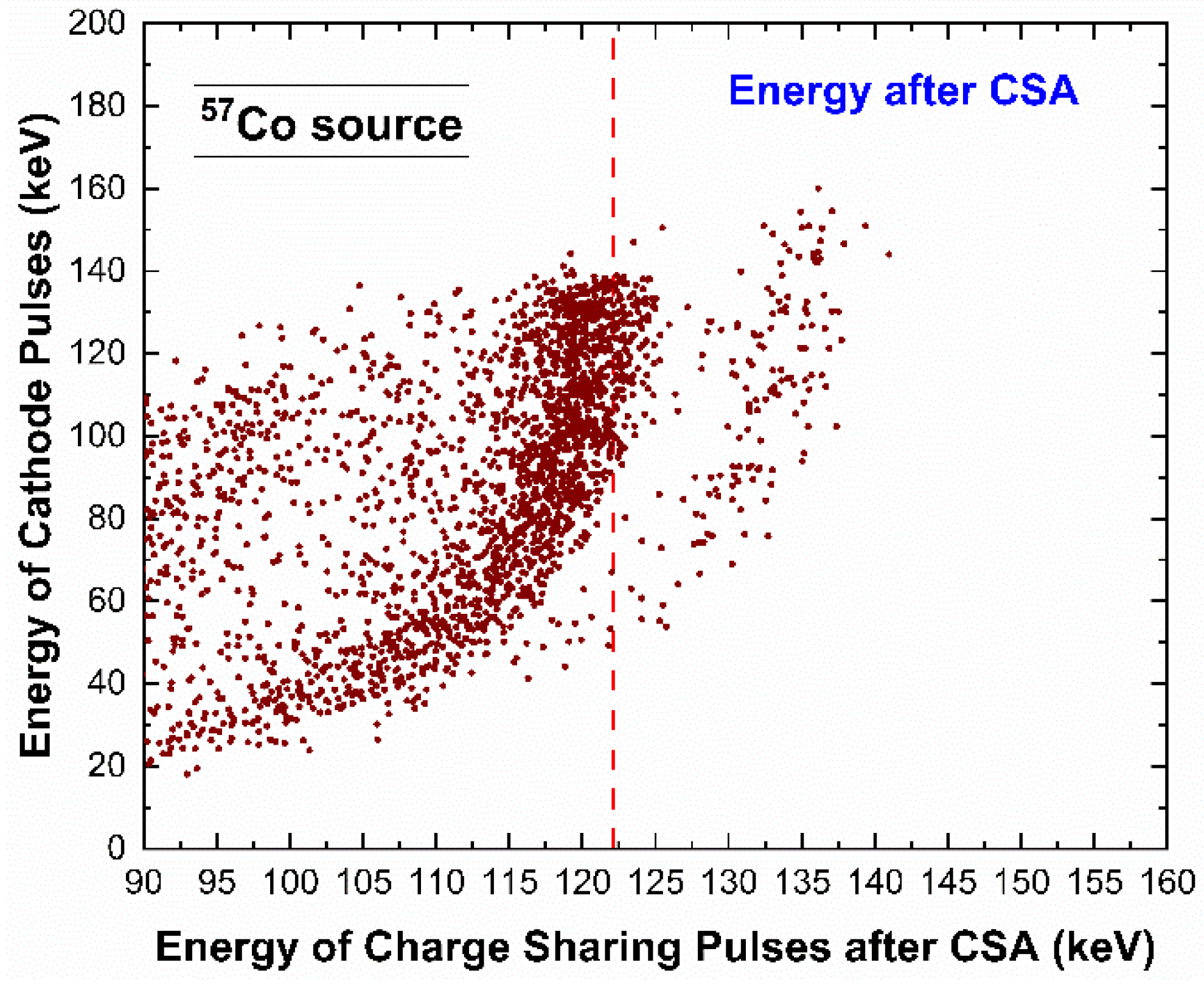

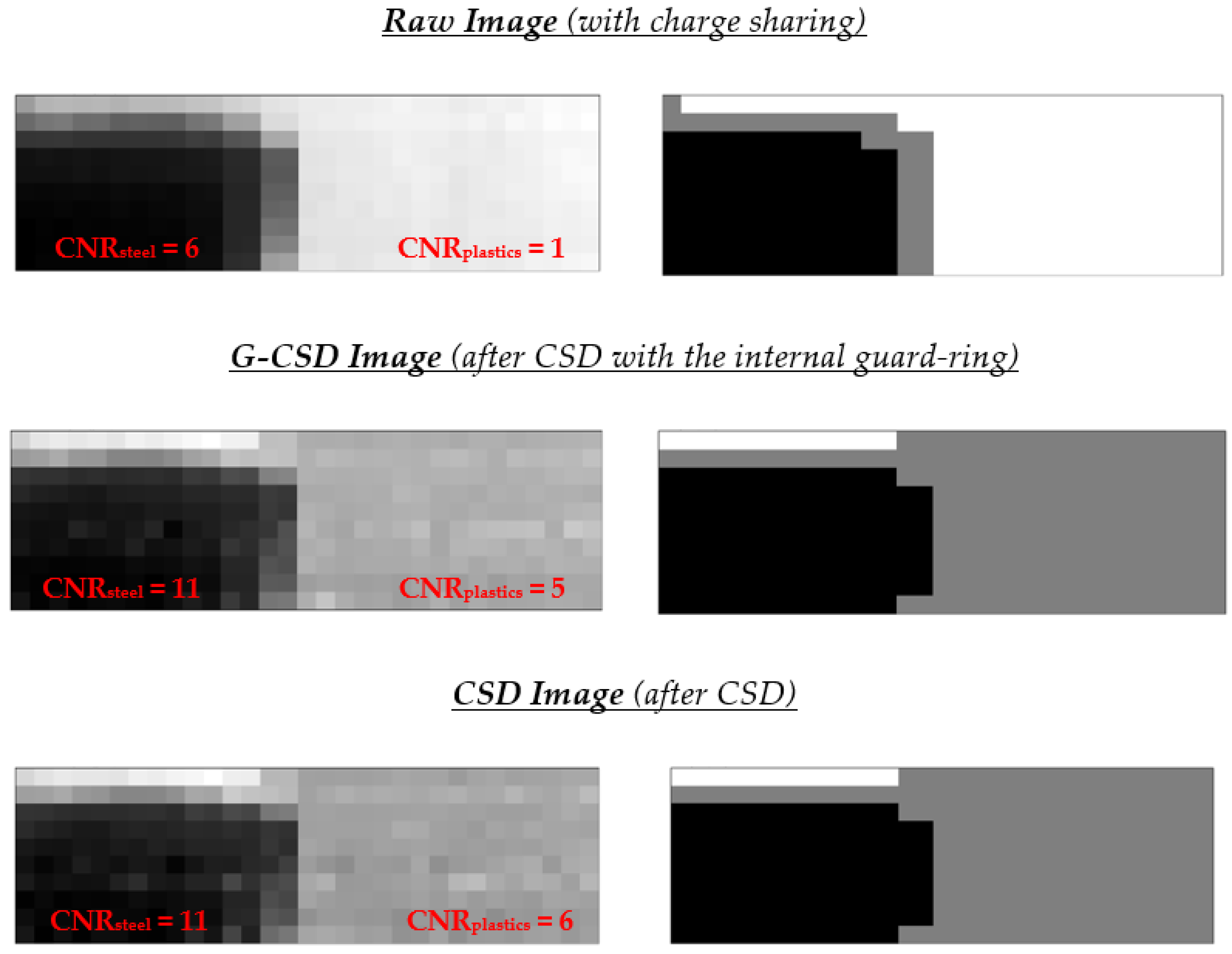
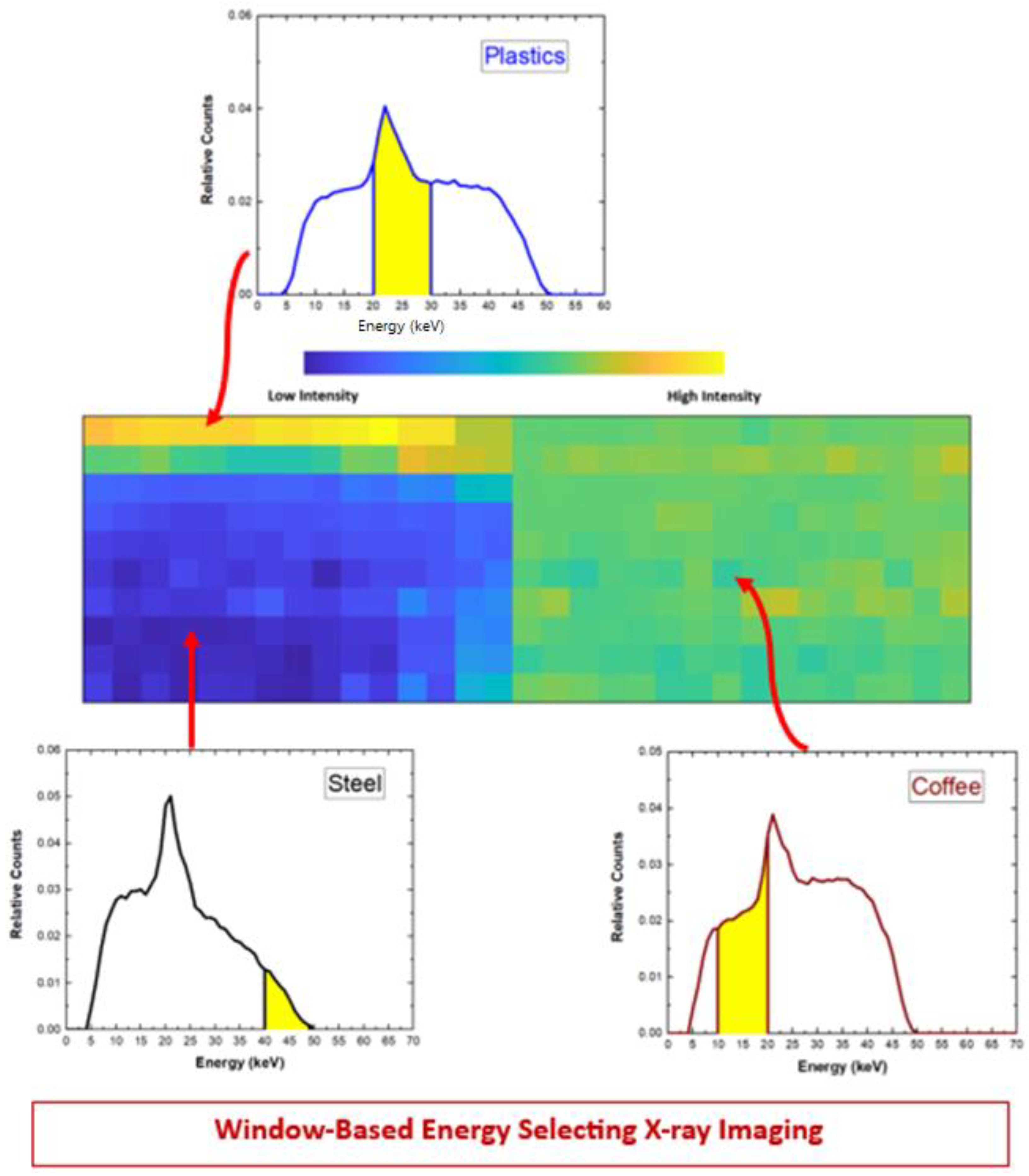

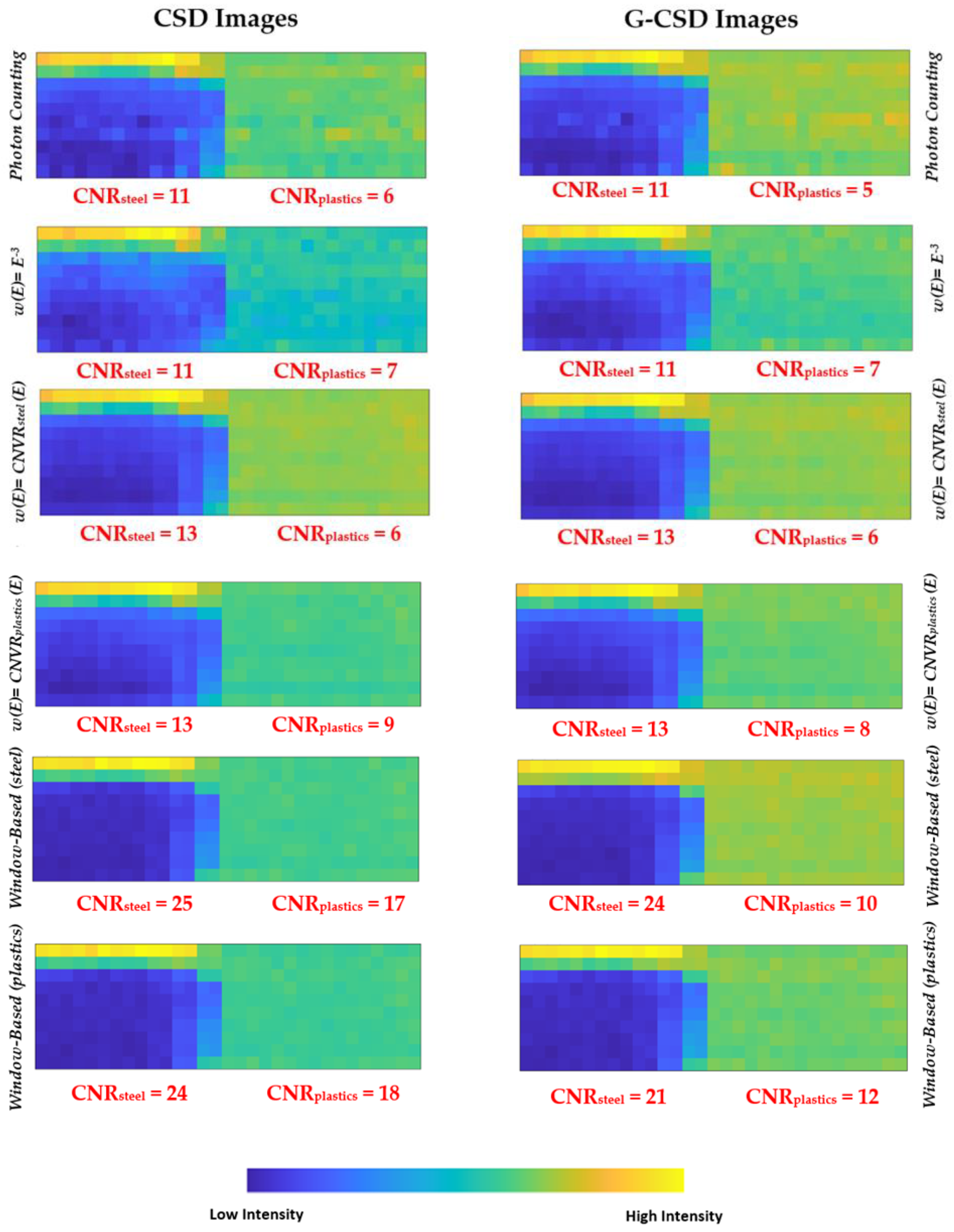
Disclaimer/Publisher’s Note: The statements, opinions and data contained in all publications are solely those of the individual author(s) and contributor(s) and not of MDPI and/or the editor(s). MDPI and/or the editor(s) disclaim responsibility for any injury to people or property resulting from any ideas, methods, instructions or products referred to in the content. |
© 2023 by the authors. Licensee MDPI, Basel, Switzerland. This article is an open access article distributed under the terms and conditions of the Creative Commons Attribution (CC BY) license (https://creativecommons.org/licenses/by/4.0/).
Share and Cite
Buttacavoli, A.; Principato, F.; Gerardi, G.; Cascio, D.; Raso, G.; Bettelli, M.; Zappettini, A.; Taormina, V.; Abbene, L. Window-Based Energy Selecting X-ray Imaging and Charge Sharing in Cadmium Zinc Telluride Linear Array Detectors for Contaminant Detection. Sensors 2023, 23, 3196. https://doi.org/10.3390/s23063196
Buttacavoli A, Principato F, Gerardi G, Cascio D, Raso G, Bettelli M, Zappettini A, Taormina V, Abbene L. Window-Based Energy Selecting X-ray Imaging and Charge Sharing in Cadmium Zinc Telluride Linear Array Detectors for Contaminant Detection. Sensors. 2023; 23(6):3196. https://doi.org/10.3390/s23063196
Chicago/Turabian StyleButtacavoli, Antonino, Fabio Principato, Gaetano Gerardi, Donato Cascio, Giuseppe Raso, Manuele Bettelli, Andrea Zappettini, Vincenzo Taormina, and Leonardo Abbene. 2023. "Window-Based Energy Selecting X-ray Imaging and Charge Sharing in Cadmium Zinc Telluride Linear Array Detectors for Contaminant Detection" Sensors 23, no. 6: 3196. https://doi.org/10.3390/s23063196
APA StyleButtacavoli, A., Principato, F., Gerardi, G., Cascio, D., Raso, G., Bettelli, M., Zappettini, A., Taormina, V., & Abbene, L. (2023). Window-Based Energy Selecting X-ray Imaging and Charge Sharing in Cadmium Zinc Telluride Linear Array Detectors for Contaminant Detection. Sensors, 23(6), 3196. https://doi.org/10.3390/s23063196

















